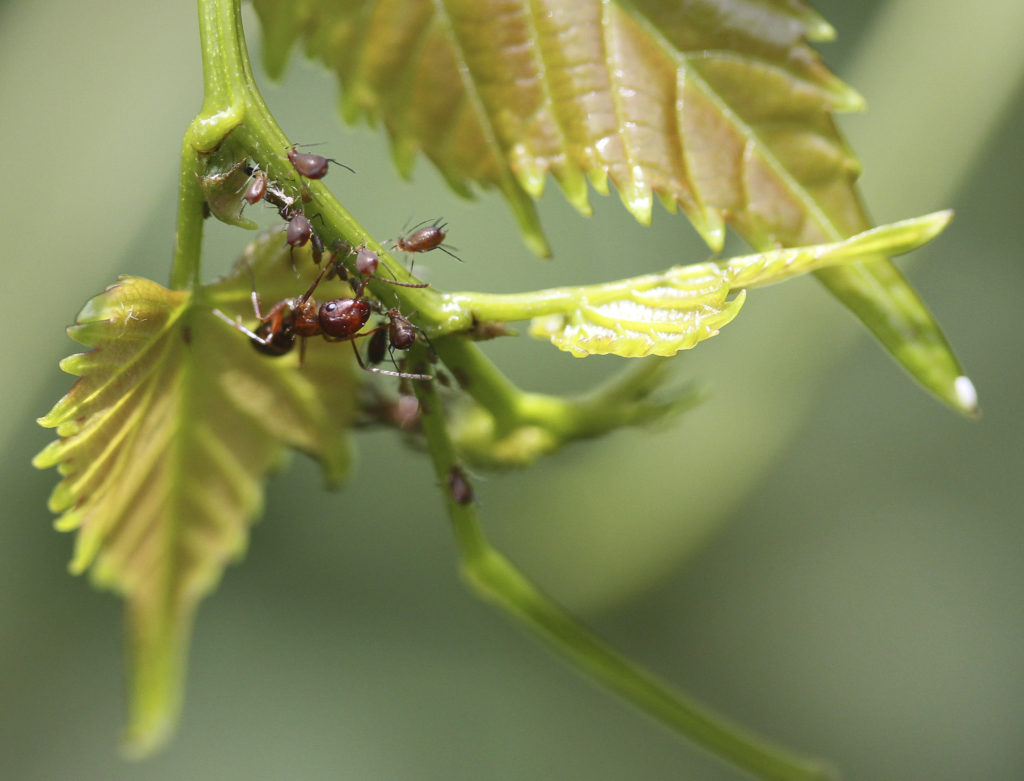Farmer Ants & Aphid Herds

By Wayne Bierbaum
Years ago, I planted two types of grapes in my backyard but now a large maple tree is blocking the light to them. All I get now from my grapes are large leaves.
As I was inspecting the plants, being hopeful for signs of grapes, I noticed patches of reddish-colored aphids and red ants that were milling around in the middle of the groups of aphids. The ants did not attack the aphids and the aphids did not try to escape from the fierce-jawed predatory bugs. The two insects definitely had some sort of association or relationship.
In the past, I have discussed symbiotic relationships—relationships where each member derives a benefit. There are many instances in the animal world of symbiotic relationships: cleaner shrimp preventing decay of the teeth of predatory fish; coyotes cooperatively hunting with badgers.
One of the most interesting, yet small-scale, examples of symbiotic relationships is that of ants farming herds of aphids. The relationship is more complex than a simple food and protection operation. Not only are the aphids literally herded by the ants, but the ants control their life cycle.
Aphids produce a sweet nectar called honeydew and obtaining this nutritional fluid is the goal of the ants. Most ant species have multiple sources of food and can live without aphids, however, the citronella ant lives almost exclusively on the honeydew produced by a root aphid.
The ants are named citronella because of the sweet citrus smell they produce when stressed or smashed. The ants herd small whitish aphids that live on the sap of roots near the soil surface. The root aphids also live on the stems of succulent plants.
The citronella ants are small and subterranean but sometimes in the spring of the year, a colony of ants will decide to move and will spill into someone’s house. They are generally not attracted to food or sugar and are disturbing because they can show up in huge numbers. Root aphids are difficult to eradicate and the suggestion is to target the ants that farm and protect them.
Aphids are frequently a danger to crops and controlling infestation frequently also targets the aphid’s friend, the ant.
At least one plant has devised a method of controlling aphids by giving appealing gifts to the ants. Okra plants are frequently infested by cotton aphids, which in turn are protected by Pheidole ants. The okra plant can produce a small sweet nodule on the under side of its leaf called a pearl body, which competes for the ant’s attention and thus leaves the aphid to the mercy of predatory insects. If an okra plant doesn’t have aphids bothering it, then the leaves have few pearl bodies. But if an infestation occurs, then all the leaves start producing increasing numbers of pearl bodies and the ants switch food sources and the aphid infestation is diminished through predators.
Aphids have many enemies such as ladybugs, lacewings, and wasps. So having the ants protect them is a real advantage. Ants will move through their herd of aphids and softly touch them with their antennae, leaving scent markers containing pheromones and hormones that slow and calm the aphids and tell the aphids where they can travel. The brushing of the ant’s antennae on the aphid is also thought to stimulate it to produce the honeydew. Ant scent markers also tell other predatory insects to leave the aphids alone. If that scent hint doesn’t work, then the ants will fight to protect their food source.
The nature of certain ants is true herding behavior. Some ants have been seen moving aphids from a seemingly diseased part of a plant to a healthier section. When a colony of ants moves to a new location, some species will carry aphid eggs with them to establish a new farm. When the life cycle of the aphid reaches the point when it should develop wings and fly, ants have been observed clipping the wings.
My red grapevine has died but the white grape has survived. Although I never get many, if any, grapes from my one remaining vine, I am still going to try to get it to prosper even if just to watch what insects inhabit it.
